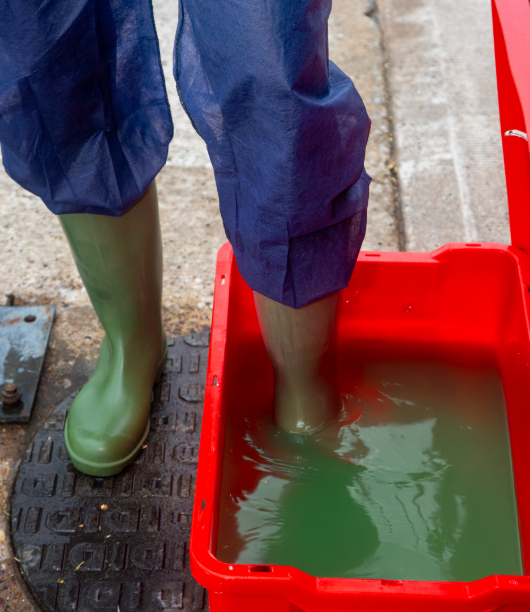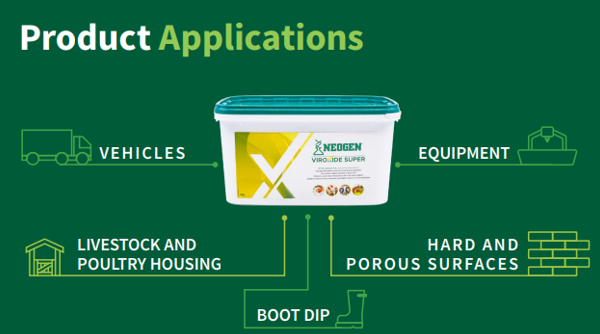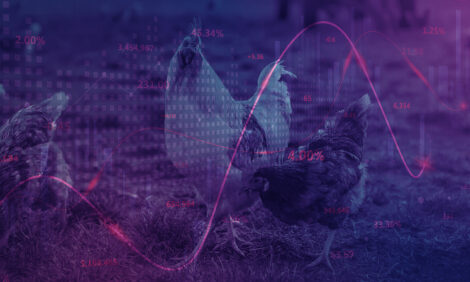



Strengthening biosecurity to safeguard flocks from Avian Influenza
Increasing your protection against Avian InfluenzaHighly Pathogenic Avian Influenza has been detected in commercial poultry flocks across multiple countries in Europe.
Avian Influenza: a persistent threat
Avian influenza (AI) continues to pose a serious risk to both wild and domesticated bird populations. Caused by type A influenza viruses, the disease exists in two forms: low pathogenic (LPAI) and highly pathogenic (HPAI). Wild birds often act as silent carriers, showing little to no signs of infection, which makes early detection and containment more difficult.
In September 2024, Neogen® Viroxide Super™ underwent re-evaluation against the H5N1 strain. The testing confirmed that the disinfectant successfully inactivated the virus within just one minute when used at the DEFRA-approved 1:200 dilution rate. This level of efficacy is critical for biosecurity protocols, particularly for vehicle disinfection points and boot dips, where fast action can help minimise the spread of infection.

The impact of HPAI on poultry production is severe. Infected birds may exhibit a range of symptoms including fatigue, respiratory distress, swelling, skin discolouration, internal bleeding, and in some cases, neurological signs. The virus can spread rapidly, resulting in high mortality rates and major economic losses. For accurate diagnosis, oropharyngeal and cloacal swabs remain essential, as the virus commonly affects both the respiratory and digestive systems.
Understanding how the virus spreads
Avian Influenza is mainly spread through contact with infected birds, their droppings, or respiratory secretions. Migratory wild birds can carry the virus over long distances, increasing the risk to commercial flocks.
Indirect transmission is also common, with the virus surviving on contaminated feed, water, equipment, vehicles, and even clothing or footwear. Because birds can be infected by inhaling or ingesting the virus, strong biosecurity measures are essential to reduce exposure.
Essential biosecurity measures for AI prevention
A strong biosecurity plan is crucial to prevent AI and protect your flock. Key measures include:
- Controlled Access: Limit entry to the production area with secure perimeters, visitor logs, and sanitation protocols. Use shower-in/shower-out systems to reduce the risk of disease spread and signage to keep people off the premises.
- Vehicle & Equipment Hygiene: Keep vehicles off premises if possible, if not possible, prior to entrance, disinfect vehicles and equipment thoroughly to prevent contamination across locations.
- Shed Isolation & Cleaning: Treat each shed as a separate biosecurity unit, use separate PPE in each building, ensure thorough disinfection and proper cleaning of water lines.
- Wildlife & Pest Control: Manage wildlife, rodents, and insects through exclusion methods and pest control programs.
- Employee Training: Ensure all staff are trained in biosecurity procedures, including disinfection and safe handling practices.
Neogen® Viroxide Super™: key to Avian Influenza prevention

Effective disinfection is a critical part of any biosecurity plan. Neogen® Viroxide Super™ is a proven solution, showing efficacy against H5N1, a common strain of avian influenza. This broad-spectrum powder disinfectant offers a cost-efficient alternative, with a dilution rate 15-51%* lower than similar DEFRA-tested products, helping maintain biosecurity without high costs.
Maintaining strict biosecurity practices is crucial to protecting poultry from avian influenza. With effective disinfection solutions like Neogen Viroxide Super, you can reduce the risk of infection and safeguard your flock. To learn more about how Neogen Viroxide Super can support your biosecurity efforts, visit here.
* According to General Orders approval data collected in April 2025 from https://disinfectants.defra.gov.uk/
(Protect your flock against H5N1 with DEFRA approved Neogen® Viroxide Super™ | Neogen)








